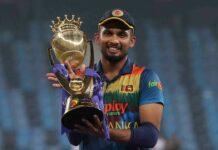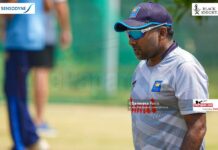With the volume of cricket played nowadays, it is the contemporary players who dominate Test cricket’s record books.
On Friday in England, Kumar Sangakkara was busy compiling another half-century and in doing so, skipping past team-mate Mahela Jayawardene and West Indian opponent Shivnarine Chanderpaul into sixth place on the all-time run-scorers list.
A quick check of that list shows that, of its top 10, nine played at least some cricket in the 21st century, with Allan Border the sole remnant of a bygone era.
Meanwhile, Stuart Broad was edging towards 250 Test wickets as he became just the fourth man to claim two hat-tricks in Tests, while last week it was Jimmy Anderson in the limelight, as he took his 350th Test wicket.
And just as modern batsmen dominate the run-scorers list, so to do 21st century bowlers on the all-time wicket-takers list, with eight of the top 10 playing beyond January 1, 2000.
Cricket.com.au felt the numbers begged an obvious question: just who are the best of the best in this era of high volume cricket?
And so we set about trying to determine a Test World XI: 2000-2014.
Some 646 Tests have been played since the first day of 2000 (including the current battle between England and Sri Lanka), and for this selection process, longevity throughout Test cricket’s most demanding period was paramount.
The first criteria therefore, was a minimum of 100 innings – with bat or ball – removing the possibility of any current stars such as Virat Kohli, Vernan Philander, Cheteshwar Pujara or David Warner sneaking into the side before their Test records have truly been determined.
Not that there’s any easy way into this World XI.
OPENERS
The contenders: Graeme Smith, Matthew Hayden, Virender Sehwag, Justin Langer, Alastair Cook.
Openers from Jan 1, 2000
Smith might be the leading run-scorer among this lot, but would Test cricket have seen a more explosive opening combination than that of Hayden and Sehwag?
Among the five leading contenders, Hayden boasts comfortably the best average, and a superior hundreds per match ratio. For those factors, both critical among opening batsmen, he gets a start.
Sehwag meanwhile, spent a portion of the mid-2000s being favourably compared by many with Sachin Tendulkar, such was his dominance and unbelievable form at the top of India’s much-vaunted batting order. His strike-rate of 83.10 is also the best of anyone throughout the period, shading the lethal Adam Gilchrist (81.97).
Smith’s record as captain also comes into the equation (he captained South Africa in a world record 109 Tests, for a 48.62 per cent win rate), however Sehwag’s match-winning ability and superior average get him across the line … just.
Honourable mentions: Herschelle Gibbs, Chris Gayle, Michael Vaughan.
No.3
The contenders: Rahul Dravid, Ricky Ponting, Kumar Sangakkara, Hashim Amla
No.3 batsmen from Jan 1, 2000
Another high-quality field here, with the numbers leaning towards Sri Lanka legend Kumar Sangakkara ahead of the likely more fancied pair of Ricky Ponting and Rahul Dravid. Sangakkara has more runs and more hundreds at a better average throughout the specified period, and for these reasons, and because his record drops significantly as a wicketkeeper, he earns his place in this side as a batsman alone.
Honourable mentions: Ramnaresh Sarwan, Younis Khan.
Middle Order (No.4, No.5, No.6)
The contenders: Jacques Kalllis, AB de Villiers, Shivnarine Chanderpaul, Mohammad Yousuf, Inzamam-ul-Haq, Sachin Tendulkar, Michael Clarke, Mahela Jayawardene.
Middle-order batsmen (No.4-6) from Jan 1, 2000
West Indian legend Brian Lara is a notable absentee from this list, having played only the first seven years of this 15-year period, however there is no shortage of quality to choose from. First place goes to Kallis, who scored more hundreds throughout the period than anyone, and enjoyed an average pushing 60 while batting from 4-6 (that’s not to mention the remarkable 239 wickets he took through the period – more than the likes of Jason Gillespie, Stave Harmison and Morne Morkel). Jayawardene and Tendulkar occupy two of the bottom three positions in terms of average on the above table, however marks of 50.91 and 52.22 respectively over 127 Tests apiece are exceptional, and they scored more runs and hundreds than anyone during the period. Chanderpaul is particularly unlucky to miss out, while AB de Villiers and Michael Clarke are both building records that will rival virtually anyone’s once their careers are complete.
Wicketkeeper and No.7
The contenders: Mark Boucher, Adam Gilchrist, MS Dhoni, Matt Prior.
Wicketkeeper-batsmen from Jan 1, 2000
Boucher took the vast majority of his world record 555 dismissals beyond January 1, 2000, with only Gilchrist coming close to him in terms of dismissals. Gilchrist did however, play 32 fewer Tests, and his batting average in the mid-40s and remarkable ability to score rapid hundreds in the lower-middle order elevate him into a category of his own. Dhoni and Prior followed the Gilchrist mould with their aggressive approaches with the bat, however the numbers indicate the Australian remains in a class of his own.
Spinner
The contenders: Muthiah Muralidaran, Shane Warne, Harbhajan Singh, Anil Kumble, Graeme Swann.
Spin bowlers from Jan 1, 2000
Despite not playing for the past four years, Sri Lanka legend Muthiah Muralidaran puts a bigger gap on his peers than we’ve seen in any other category, making his selection in this category perhaps the simplest of all. But nothing is ever simple with Muralidaran. Critics of the off-spinner will point to his multitude of wickets against Bangladesh and Zimbabwe, however 133 Test scalps against those two sides represents 23 per cent of the 573 he claimed throughout the specified period, with 77 per cent coming against the other seven nations to provide a balanced ratio in terms of wickets taken.
Honourable mentions: Daniel Vettori, Danish Kaneria.
Fast bowlers
The contenders: Glenn McGrath, Dale Steyn, Shaun Pollock, Jason Gillespie, Mitchell Johnson, Makhaya Ntini, Chaminda Vaas, Stuart Broad, James Anderson, Brett Lee.
Fast bowlers from Jan 1, 2000
The two names at the top of this list stood out immediately; McGrath for his stunning average of 20.52, and Steyn for his remarkable strike-rate of 42.1 – the best in Test history for bowlers with more than 200 wickets. With the rest of their numbers also exceptional, the pair is a walk-up start to take the new ball.
Johnson’s stunning run of form over the past nine months elevates the Australian into serious contention, with South Africans Pollock and Ntini his chief rivals for the third paceman’s spot. With Kallis in the middle order, the left-arm variety seems the sensible option, and considering Johnson has taken four more wickets than Pollock throughout the period in 11 fewer Tests, at a comfortably superior strike-rate, as well as a better average and strike-rate than Ntini, he gets the nod.
Honourable mentions: Jason Gillespie, Chaminda Vaas, Stuart Broad, Zaheer Khan.
Test World XI: 2000-2014. Matthew Hayden, Virender Sehwag, Kumar Sangakkara, Jacques Kallis, Sachin Tendulkar, Mahela Jayawardene (c), Adam Gilchrist, Mitchell Johnson, Dale Steyn, Muttiah Muralitharan, Glenn McGrath.
The opinions expressed here are the views of the writer and do not necessarily reflect the views and opinions of Cricket Australia

















